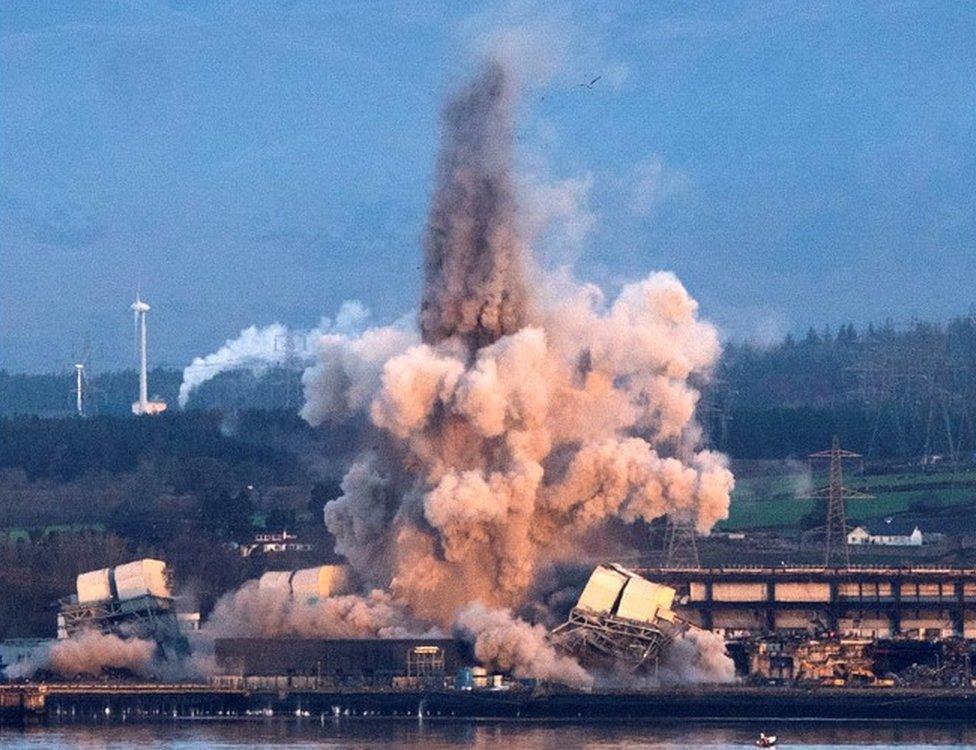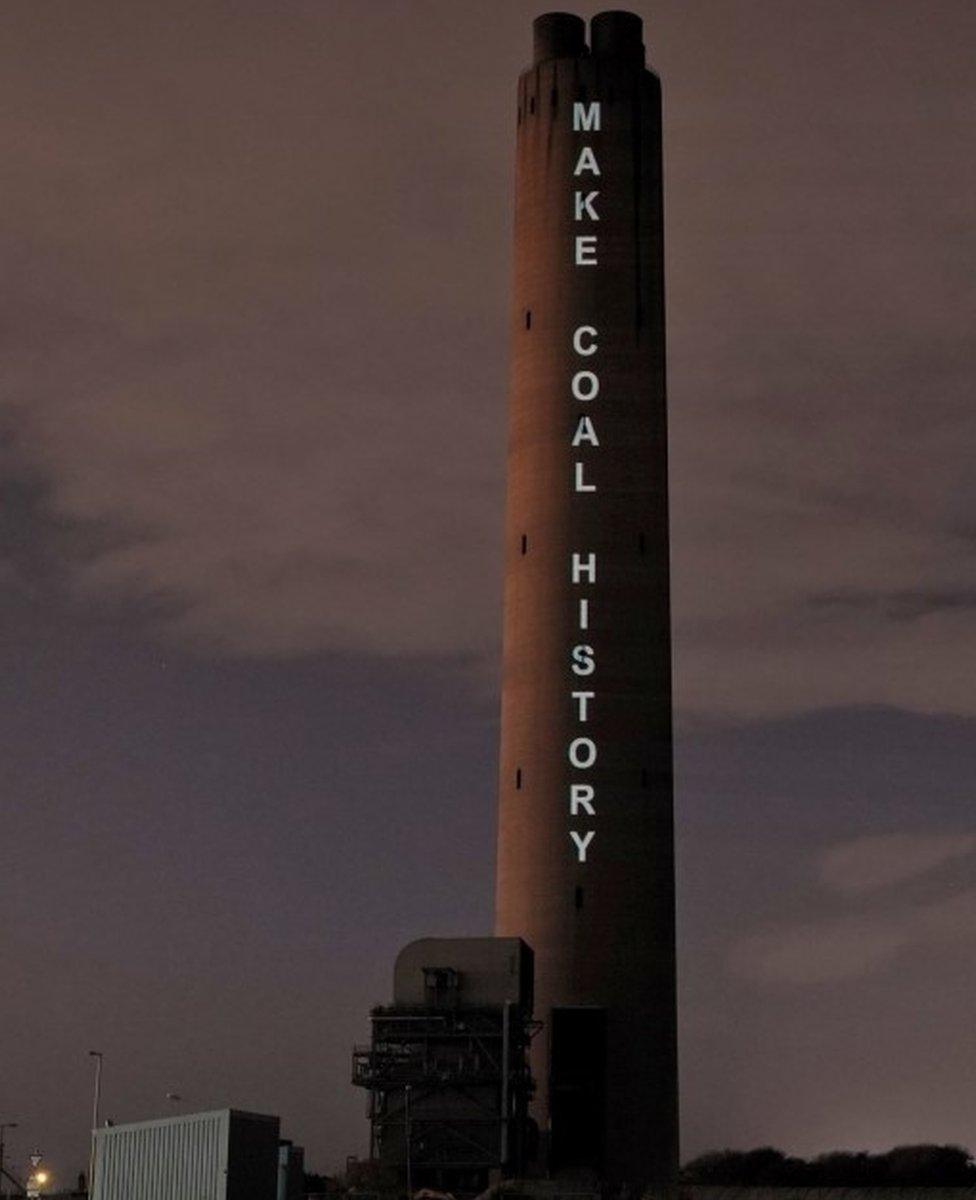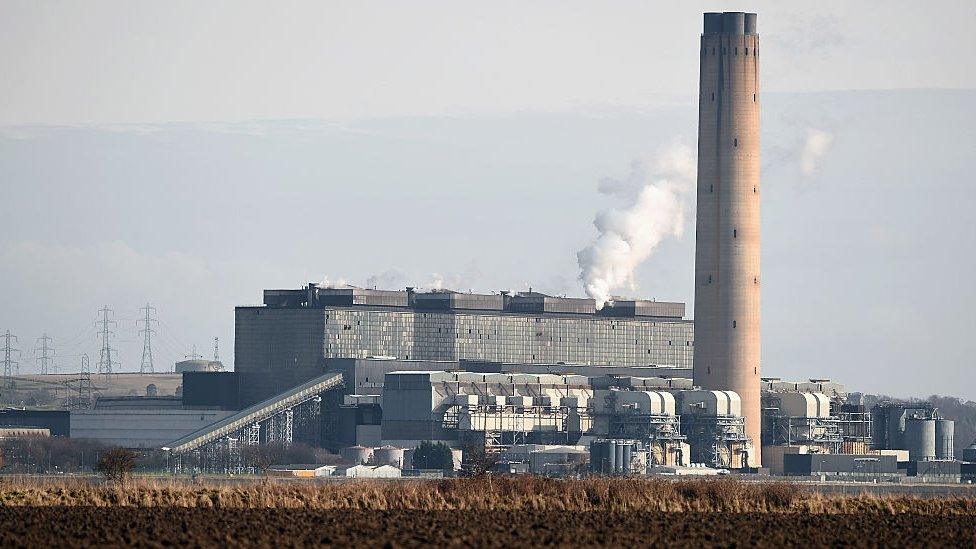Longannet power station chimney blown up
- Published
The 600 foot high chimney stack at Longannet power station in Fife was brought down by controlled explosion
The 600ft chimney at the former Longannet power station has been demolished in an explosion.
The Fife site produced Scotland's last coal-fired energy until it ceased operation in 2016.
The chimney was the largest free-standing structure in Scotland and was a local landmark for generations.
First Minister Nicola Sturgeon pushed the button to ignite 700kg of explosives, bringing down the chimney stack.
Ms Sturgeon said: "Today's event is a symbolic reminder that we have ended coal-fired power generation in Scotland, as we work in a fair and just way towards becoming a net-zero nation by 2045.
"Our goal is to generate 50% of overall energy consumption from renewable sources by 2030, and Scotland's energy sector is well placed to deliver on the key investments in renewables, hydrogen and energy storage required to achieve this.
"Growth in these sectors over the next decade will be transformative for Scotland, delivering further good, green jobs, strengthened energy security, and benefits for local communities as we decarbonise industry and society to mitigate the worst effects of climate change, in a way that leaves no-one behind."
Owner Scottish Power had projected the environmental slogan "Make Coal History" onto the chimney at night ahead of the demolition.

Longannet was once the largest coal-fired power station in Europe. Its buildings have been removed in a series of controlled explosions in the years since it closed.
As well as the environmental slogan, multi-coloured "global warming stripes", created by Professor Ed Hawkins of Reading University, were also projected onto the chimney.
Scottish Power said the stripes showed the change in global temperature from 1850 to 2020, with shades of blue showing cooler-than-average years, and red showing years that were hotter-than-average.
'Landmark day'
Keith Anderson, chief executive of Scottish Power, said: "At Cop26 in Glasgow, we were proud to show the world that Scotland has already made coal history.
"As a 100% energy company, we are committed to helping the UK end its reliance on fossil fuels.
"For half a century, Longannet's chimney has dominated the Firth of Forth skyline. We bade farewell to that landmark today - however this is a landmark day for Scotland too.
"Watching the chimney of Scotland's last coal-fired station fall today represents a real milestone, as the UK moves away from the large polluting power stations of the past and accelerates down the road to net-zero emissions."


The demolition marks an important moment in Scotland's energy transition but it's only a symbolic one.
That's because it's more than five years since coal was last burnt to generate our domestic electricity.
But symbolism is important since a few short miles away politicians spent two weeks in November trying to convince other countries to do the same.
So, why have we been able to do it now when countries like India and China are struggling?
Investment is one thing but another major reason is transition fuels like North Sea gas and nuclear.
But in 2019 we generated 97% of our net electricity demand from renewables with huge amounts of offshore wind in the planning stages.
For us the revolution is already happening but the hope now is that the rest of the developing word skips that middle step and switches straight to renewables.

Multi-coloured "global warming stripes" have been projected onto the chimney at night.
Longannet began generation in 1970 and Scottish Power said it was the largest coal-fired power station in Europe when first built, remaining the largest in Scotland until it closed on 31 March 2016.
At the height of operations, it burned coal from around the world including from as far away as Russia and Colombia, as well as from Scottish open-cast mines.
Typically, it consumed four million tonnes of coal per year and at full production could make enough electricity to power two million homes.
The demolition of Longannet is being carried out by Scottish Power contractor Brown and Mason and work to remove materials at the site will continue into 2022.

Scottish Power projected the environmental slogan "Make Coal History" onto the 600ft structure ahead of its demolition
Ignacio Galan, chairman of Scottish Power and Iberdrola, said: "Longannet played an important role in Scotland's history as its largest coal station, but the future can only be about clean energy.
"Everyone working at Scottish Power and the wider Iberdrola Group should be proud to be contributing to this impressive transition from fossil fuels to renewables."
Lang Banks, director of WWF Scotland, said: "It's an historic moment to see the chimney of Scotland's last coal-fired power station come down.
"We have successfully made coal power history in Scotland and rapid progress is now being made globally towards cleaner, renewable energy."

Longannet was Scotland's last coal-fired power station until it was closed in 2016
- Published22 August 2019

- Published24 March 2016
